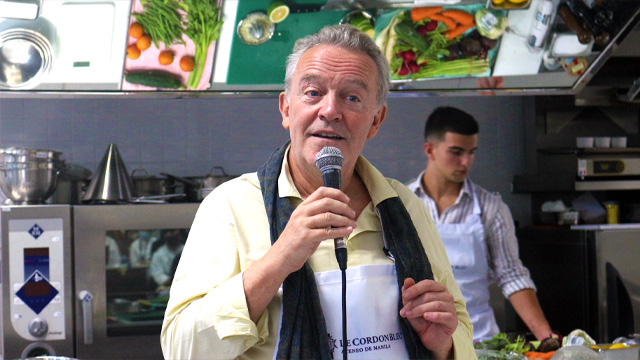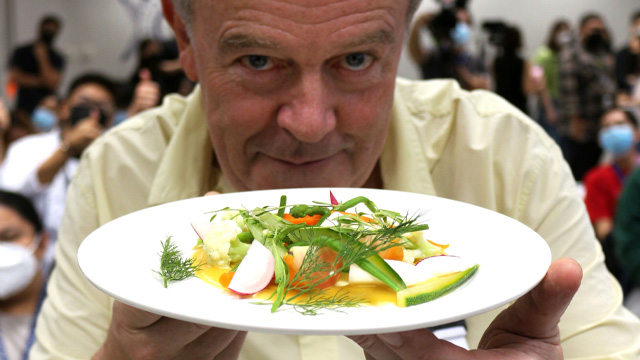If, like me, you’ve been encrusted in the spirit of foodie pop culture, you’ve probably watched the 8-hour series The Bear. The brilliant show was equal parts delicious food, a relatable toxic work environment, and disillusionment (over so-called dream jobs or the price of career success). In every scene, your mouth watered but your head also ached as the show exposed that even the best job in the world was not immune from the threat of burnout and catastrophic stress. It’s tempting to slide into that jaded pessimism, but I have good news: I found proof that there’s hope.
In this particular case, hope’s name is Chef Alain Passard, the happy 66-year-old French chef who owns the 3-Michelin-starred Parisian restaurant L'Arpège. And for a little more than an hour last October 21 at the Le Cordon Bleu Ateneo de Manila Institute, I got to witness him in his element, melodiously impassionately orating in French to Le Cordon Bleu Ateneo’s aspiring chefs and dancing gracefully through the stage kitchen to execute and show us his two signature dishes. “Every day feels like my first day at work,” he proclaimed with a sparkle in his eyes more than once during the whole talk.
Now as I take you on this delicious journey through Chef Alain Passard’s food--showing you how a dish can transcend into art--I’ll also be sharing with you some nuggets of wisdom Chef Alain shared that you can take to heart and bring into your own kitchen, or just maybe generally, your life. As celestial as his achievements may be, you’d be surprised that a lot of it will sound pretty dare-I-say-it doable. So doable, in fact, that a lot of it you’ll find that your mom is already doing.
Here are Chef Alain Passard’s best advice for any cook:

1 Ask: What does your dish need?
“You have the best job in the world,” Chef Alain told the Restaurant Entrepreneur students. He was speaking from experience. He then makes comparisons of how as a chef, one is an artist. He tells the students to constantly taste and smell their work asking, “What does it need?” Similar to how a painter might decide whether a composition needed more color or less, as a chef, you should ask: does your dish need sweetness, acidity, or maybe more salt?
2 “Use your five senses.”
The first dish that made Chef Alain fall in love with cooking wasn’t a multi-course meal nor even a grandiose steak, but instead, a humble 3-minute boiled egg. Fifty-one years ago, Chef Alain began his career and at 26 earned his first Michelin star all because of one perfectly undercooked egg. That runny creamy golden egg yolk that warmed his palate catalyzed a decades-long career that would revolutionize fine dining.
As the son of artists (his mother was a fashion designer and his father a musician), they raised him in a household that encouraged paying close attention to details, a perspective he took with him as he used his five senses to fully enjoy that very simple dish.
In Le Cordon Bleu, Chef Passard demonstrated his keen attention as he carefully cut a precise straight line around a fresh egg with a very sharp paring knife. Students gawked at the clean-cut as he then slowly poured out the egg white, leaving behind that rich golden egg yolk sitting plump inside the white shell. He was creating right in front of us one of L'Arpège’s signature appetizers that’s sweet, savory, hot, and cold all at the same time. He then floats the half-empty egg into a pan filled with 60-degree Celsius hot water.
For context, 60 degrees Celsius is the temperature of tea or coffee when it’s as hot as can be but just cool enough to gulp down if desired. This is far from the rolling boil you make your breakfast eggs with. The water has to be maintained in that gentle heat without as much as a simmer that could topple and empty the egg into the cooking water. Once ready, the warm, gelled yolk would be dashed with a little maple syrup, then topped with a savory, spiced cream whipped to soft peaks.
3 “Take pleasure” in what you cook.
The next dish, Garden Composition, is deceptively simple. Almost rustic in its presentation, slices of blanched string beans, red beet, broccoli, cauliflower, mushroom, carrots and cabbage, fresh cherry tomato, arugula and Mizuno, and julienned pickled horse radish and a slice of pickled turnip, all come together atop an airy sweet and sour emulsified sauce. Chef Passard’s inspiration for the dish is harvesting fresh vegetables from his garden and laying them in his basket. With this dish, he transports you away from your chair and brings you over to his garden on a quaint, pastoral walk where you get to sample nature’s gifts at their best, when vegetables are so fresh they’re sweet.
He replicates that joy from the garden to the kitchen. As he tastes his flawless nappe sauce, you see him sparkle with delightful approval. You see the love as he places, piece by piece, his perfectly curated vegetables, and as he finishes it, he presents his work of art with gleeful pride. It is because Chef Passard took pleasure that he can share this pleasure on a plate.

4 “Source your ingredients well.”
When the Garden Composition is finally put together, it looks effortless. Part of it is L'Arpège’s philosophy to highlight the vegetables by minimizing how much it’s altered by the chef’s hand. Chef Passard likens it to putting makeup on a beautiful woman--you only need to highlight to let their natural beauty shine through. This means though, that in order for this philosophy to work, the ingredients must be fresh and intentionally sourced. For Chef Passard, this has led him to own multiple farms spread throughout France. The farms all have different climates, soils, and conditions, enabling every fruit or vegetable to grow in the best natural condition for it to taste its best. Putting together these vegetables on one plate may seem simple, but Chef Passard starts from the seed.
You might be thinking now: how is this relatable? I can’t grow my own vegetables or own three farms? Except for a few rich hacienderas or hacienderos who might have their own farms, most city dwellers are doomed to grocery aisles. But if you quirk your head to the side, you’ll see the answer is simpler.
Go to your local wet market aka palengke and find your suki. Your mom, your lola, and probably further down your ancestors have been expertly sourcing their veggies since time immemorial. Oftentimes, nothing beats the freshness of veggies you get there. And if you befriend your local vendors, you’re almost guaranteed the cream of the crop.
5 Be agile and embrace challenges.
These are not Chef Passard’s exact words, but it was the general tone of his advice to the students who asked questions of the same flavor: “What do I do about burnout? How do I stay passionate?”
Chef Passard has categorically never experienced burnout because instead of perceiving adversity as challenges or obstacles, he sees them as opportunities. Cooking through the four seasons of France means every three months the available produce changes. With wildly different ingredients four times a year, he feels as though it is a brand-new exciting job each time. It’s this agility, adapting to what is there and available, that enables Chef Passard to create new recipes ad infinitum.
I’ve often complained to my mom, a brilliant home cook, about how she barely ever writes recipes down. It’s frustrating especially when she comes up with something extraordinary on the fly and every spoonful, for me, tastes magnificent yet poignant in that it might be the last time I ever get to taste it because there’s just no recipe. But perhaps the transience of those spontaneous dishes is part of what makes them so delicious--not just for me, but also for the cook, who embraced the moment, let her instinct take over, and took what was in her pantry, and fridge, and innovated something delicious.
What is it that makes some dishes "just okay" and some dishes sublime works of art?
6 Cook with love.

I have a confession: French cuisine isn’t my favorite. The Filipino palate, my palate, has a penchant for strong bold flavors and has a higher threshold for richness, sweetness, and acidity. Filipino food is meant to be enjoyed family-style; it’s a hodgepodge buffet, a boisterous spread with dips and sauces over a canvas of rice on plates, bowls, or banana leaves with the background music of raucous laughter or off-key karaoke. French cuisine—or, at least, the kind enjoyed in fine dining restaurants--is slowly served, one by one, in small portions, assigned to particular tableware, to nondescript classical music. Every dish, though repeated across a table, was plated for an audience of one.
Don’t get me wrong, I still love French cuisine, just in a different way. But as Filipino food represents my love for the warmth of home and nostalgia, French cuisine for me is like going on a well-thought-out romantic date, like going to a museum or watching a movie. French cuisine whispers, like a lover insinuating you to come closer and listen. If you’re not well-versed in the language of French cuisine, you might miss the whole story as you’d be lost in the gentle twists and turns.
The reason why food can be so transcendent is the silliest, cheesiest reason: love. Cutting through the technicalities of gastronomy, cooking is an emotional undertaking. It’s when the artist, the chef, or the home cook infuses their soul into their creation that it becomes more.
“Love what you do,” Chef Passard repeats again and again. “You have to love what you do. I love what I do.” And he says this in different variations.
When you cook, he says, you have to feel it. And what you feel, goes into the food.
As I sliced into perhaps the most tender piece of steak I’ve ever had and put it in my mouth, I tasted that secret ingredient. I might have missed a note or two, but the most important ingredient was star-bright. You can tell just how tenderly this cut of beef was handled. It tasted almost sweet as it melded with the light bouquet of the savory, tart, well-rounded robust red wine reduction. The flaky biscuit, a mix of herbs and mushrooms wrapped in a flaky, buttery crust, served as an earthy counterpoint that refreshed the palate and kept every bite of that steak as fresh as the first.
Don’t take it from me, but maybe appreciate your mom, your tita, your lola, and others like her who love cooking for their families. Their way of cooking just so happens to be backed by this 3-Michellin-starred globally-acclaimed chef, an anachronistic beacon against the peril of modern cynicism and living proof that dream jobs do exist: the secret ingredient is always love.
Is it a coincidence that this very dish I was eating is actually an homage to his grandmother Louise? I think not.
[ArticleReco:{"articles":["18357","19434","24949"]}]
***

